Guitar Speaker Power Handling
by Kurt Prange
The power rating of a guitar speaker is an indication of how much power it can handle without being damaged
thermally or mechanically. It is not an indication of how loud the speaker will sound in comparison to other
speakers. Let’s examine the basics of how speakers work, how the power rating is determined and look at things
from the perspective of the guitar amplifier so that we can choose guitar speakers that will last a lifetime.
How an Electrodynamic Loudspeaker Works
Guitar speakers are a type of loudspeaker known as electrodynamic or “moving coil” loudspeakers. The magnetic
circuit (composed of front plate, back plate, pole piece and magnet) and voice-coil make up the motor of a guitar
speaker. An alternating electrical current flowing through the voice-coil generates an alternating magnetic field
perpendicular to flow of current through the coil. The magnetic circuit creates a strongly focused magnetic field
in the air gap between the front plate and the pole piece on which the voice-coil is centered. The voice-coil is
pushed and pulled through the air gap based on the interaction between these two magnetic fields. Since the
speaker cone is connected to the voice-coil, it now has a mechanical force with which to push air particles and
make sound.
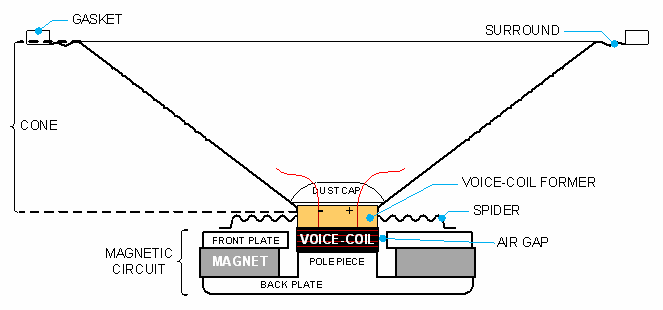
Thermal Damage
Speakers are transducers. They convert electrical energy provided by an amplifier into acoustical energy. They
are actually very inefficient transducers because most of the electrical energy is converted into heat instead
of sound. The reference efficiency (ratio of acoustic power out to electrical power in) for most guitar speakers
is around 2% to 6%, which means that 98% to 94% of the electrical energy is dissipated in the form of heat.
From the aspect of power dissipation, a guitar speaker can be modeled as a resistor. Most guitar amp enthusiasts
are familiar with the equation for electrical power and how it can be used to determine the power dissipated across
a resistor. Resistors can be thought of as transducers that intentionally convert electrical energy to heat in
order to create a voltage drop. Resistors have a power rating that indicates how much power they can dissipate
before being damaged and this rating is analogous to the speaker power rating.

The voice-coil is the electrical interface of the speaker and is given a “nominal impedance” specification
(e.g. 4, 8 or 16 Ω) which can be used to approximate power dissipation when connected to an amplifier.
(The actual impedance of the voice-coil varies with frequency). Just as a resistor will eventually burn up if its
power rating is not high enough, the speaker’s voice-coil will burn up if it is overpowered by the amplifier.
One of the most common symptoms of an overpowered speaker is a burned voice-coil, which usually measures as an
open circuit on an ohm meter. No sound can be produced by a speaker with an open voice-coil. An overheated
voice-coil former may also become warped and begin to rub against the pole piece causing the speaker to
buzz loudly.
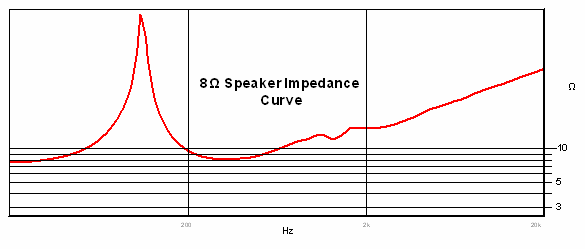
Mechanical Damage
Loudspeakers can be damaged mechanically by over-excursion of the voice-coil and cone. This is more common with
old speakers that have worn suspensions and adhesives, but may also occur at extreme low frequencies outside of
the speaker’s useable frequency range. When over-excursion occurs, the voice-coil can become misaligned or
bottom out. The cone and suspension (surround and spider) can also become stretched or torn.
How the Speaker Power Rating is Determined
Many speaker manufacturers rate their speakers based on industry standards similar to IEC 60268-5 or AES2-1984.
These standards specify a pink noise test signal with a crest factor of two (i.e. 6 dB) which is meant to
simulate the transient character of music having an average value, as well as frequent instantaneous voltage
spikes that swing up to twice the average value. Pink noise is a particular type of random noise with equal
energy per octave and actually sounds like a space shuttle launch. The test signal is applied to the test
speaker for a few hours, allowing for a reasonable way to test the speaker’s real world thermal and mechanical
capabilities. After testing, the speaker must be in working order, without permanent alteration of its
technical features. The power rating is calculated using the RMS value of the applied voltage and the minimum
value of electrical impedance within the working range of the speaker.
Guitar Amplifier Power Output Ratings
The power output rating of a guitar amp is mostly a ballpark figure for what it can put out. Amp specifications
commonly list power output in a form similar to the following:
Power Output: 50W into 8Ω at 5% THD
This type of power output rating is obtained by using a sine wave from a signal generator (usually 1 kHz) as the
input signal. The 5% THD (total harmonic distortion) figure means that the sine wave was able to generate 50W of
power output with relatively low distortion (near the threshold of clipping or overdrive). THD measurements were
one of the first conventions used to objectively compare the fidelity of audio amplifiers.
Guitar amps are unconventional audio amplifiers. While most audio amplifiers are designed to keep distortion as
low as possible, guitar amplification has evolved to where overdrive distortion is usually a requirement. For
example, the Marshall® JCM800 2203 is a 100W tube amp that has a highly regarded overdrive sound. The owner’s
manual lists the power output as follows:
Typical power at clipping, measured at 1kHz, average distortion 4% 115 watts RMS into 4, 8, 16 ohms. Typical
output power at 10% distortion 170 watts into 4 ohms.
This example shows that for many guitar amplifiers, the power output rating (100W in this case) is not a maximum
power output rating, but more of a ballpark clean power output specification.
RMS and Overdrive Distortion
RMS (root mean square) is a kind of average value that can be used to compare the power dissipation from
different signals on equal terms. For example, a 20 VDC power supply dissipates the same amount of heat across
an 8 ohm resistor as a sine wave with an RMS value of 20 VAC.
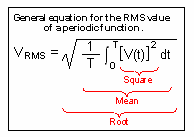
Guitar amp output ratings are usually based on a sine wave at low distortion, but if the volume is turned up
further or a gain boosting effect is used, the sine wave becomes more overdriven and can approach the shape of a
square wave. The RMS value of a square wave is equal to its amplitude, while the RMS value of a sine wave is
equal to its amplitude divided by the square root of two.
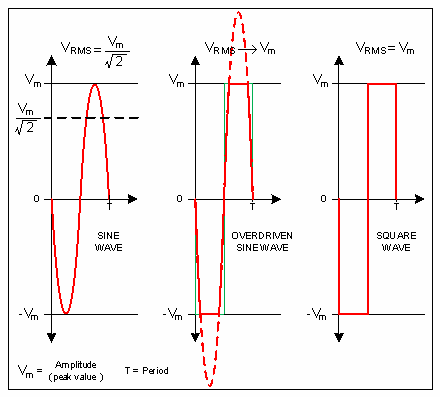
Plugging the RMS values into the equation for power shows that a square wave dissipates twice as much power
across the same load as a sine wave with the same amplitude.

This simplified overdrive distortion model illustrates how the 100 watt Marshall® amp which puts out 115
watts at 4% THD could put out an additional 50 watts at 10% THD.
Tube vs. Solid State Outputs
Many tube guitar amps use output transformers with secondary taps connected to an impedance switch allowing for
the same power output when connected to 4, 8 or 16 ohm load impedances. Solid state amps do not use output
transformers and do not have the same power output when connected to different load impedances.
For tube outputs, it’s important to match the load impedance to the amp’s output impedance. For solid state
outputs, it’s important to use a load that is greater than or equal to the rated minimum load impedance and to
know the amp’s power output at that load. For example, the Fender M-80 is a solid state amp rated for 69 W(RMS)
at 5% THD into 8 ohms and 94 W(RMS) at 5% THD into 4 ohms (the minimum load impedance).
With solid-state amps, overdrive distortion generated by the power-amp is not generally considered musically
pleasing, so most people will not exceed the amp’s low THD power rating. Tube power amps, on the other hand,
are often played well beyond their low THD rating.
Amps with Multiple Speakers
When an amp uses multiple speakers the output power is divided between them. The nominal impedance of each
speaker should be the same value so that power is distributed equally and so that the output impedance of the
amplifier can be matched.
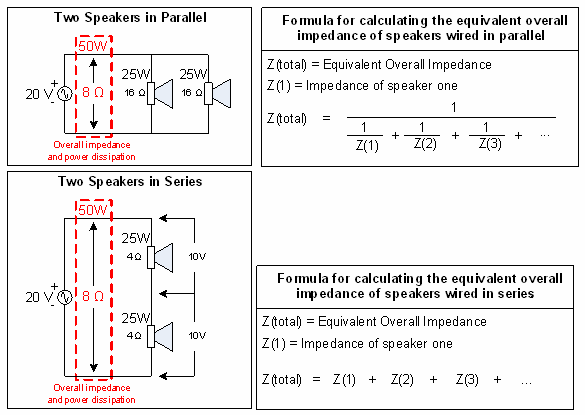
Choosing Guitar Speakers to Last a Lifetime
There is no standard method used by all amp manufacturers when selecting an appropriate speaker power rating.
If you want to choose a speaker to last a lifetime, you’ll want to choose a speaker that can handle the maximum
amount of preamp and power amp overdrive distortion that can possibly be put into it and safely avoid exceeding
the speaker’s thermal limits. In the case of single speaker setups, this means choosing a speaker rated for at
least twice the rated output power of the amp. For multiple speakers, choose twice the rated power that would
be distributed to it.
You might decide to go with a lower power rating because you know that you’ll never be cranked at full power and
love the sound of a lower power rated speaker. In the same way you may choose a speaker with a much higher power
rating because of the way it sounds.
A Real World Example: Speakers for a Fender® ’65 Twin Reverb® Reissue
1) Determine the rated output power of the amp.
Amplifiers have two power ratings: power consumption and power output. The power consumption is always much
higher than the power output. In this case the output power is 85 watts RMS and the power consumption is 260
watts.
2) Determine the output impedance for that output power rating.
In this case it is 4 Ω.
3) Determine the number of speakers.
In this case there are two 12” (8 ohm) speakers wired in parallel for an overall impedance of 4 ohms.
For this amp, speaker choices to last a lifetime should be rated for at least 85 watts each. There are a lot of
speaker choices rated for 100 watts and this rating would be very safe. Actually, the stock speaker for this amp
is the Jensen C12K and it is rated for 100 watts. □
Kurt Prange (BSEE) is the Sales Engineer for Amplified Parts in Tempe, AZ
(amplifiedparts.com). Kurt began
playing guitar at the age of nine in Kalamazoo, MI. He is a guitar DIY’er and tube amp designer who enjoys
helping other musicians along in the endless pursuit of tone.

